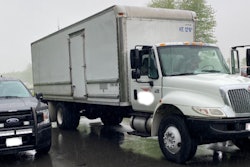Trucks, engines and other components have changed dramatically over the past 25 years and truck drivers are the major inspiration for this evolution.
“Nowadays, the driver is as much our customer as the buyer,” says Kevin Flaherty, senior vice president of sales at Mack Trucks. “The drivers’ influence is one of the top two or three issues affecting equipment changes in the last 25 years.”
From the drivers’ perspective, two or three equipment characteristics stand out. The way a
truck rides and the amount of available power top the list according to many. Bert Winn, of Winn Trucking, drives a ’93 Pete 379. “Air ride and bigger power have been two of the biggest changes,” he says.
Engine manufacturers allowed horsepower to migrate upward from high 200- to low 300-hp ratings in the late 1970s to today’s top of the line 500- and 600-hp ratings. Cummins ISX Signature, Caterpillar’s C16, rated at 600, and Detroit’s Series 60, rated at 575, top the modern horsepower list.
And today we have 18- and 13-speed transmissions and heavy-duty drivetrains to accommodate the increased power. Such enormous power is also complemented nowadays by flat torque curves unheard of even 10 years ago. This provides today’s drivers with torque in widened rpm ranges and gives trucks the ability to pull at much lower rpms than was previously possible.
Older drivers will recall their bosses telling them to keep their engines “wound up tight” in the days when Detroit’s 318 and Cummins 290 were typical power. In those days, lugging was a cardinal sin. Today, maintaining low rpms is seen as a fuel saving behavior.
Chuck Blake, veteran service engineer at Detroit Diesel, attributes such upgrades in performance to electronics. In the days before turbochargers were widely used, fast engine speed was the only way to supply enough air to the engine to maintain power.
“Diesels with mechanical governors and high governed rpms, typically 2,100, and 200 to 300 rpm overruns, meant that the only way to control top end road speed was axle ratio,” Blake says. “It also meant rpms had to be kept up to maintain speed. There was very little drivability below 1,500 rpms.”
Now, Blake says, electronic controls allow engines to run at lower speeds and allow more torque to be available at the bottom end. In essence, electronics have allowed fuel economy and driver-pleasing performance features like low-end torque and fancy split-speed transmissions to develop at the same time.
“Twenty five years ago, low peak torques of 750- to 900 foot-pounds made 10-speed transmissions almost a necessity,” says Blake.
Contrary to popular opinion, more torque and more horsepower do not necessarily mean lower fuel mileage. “If you drive a big horsepower engine correctly, it will give competitive fuel mileage,” Blake says.
Along with electronics pioneered by Detroit in the late 1980s, turbos were a significant factor in allowing all this to happen. At first, turbos were used only to compensate for the lack of air at high elevations. But by the late 1970s, turbos were being used in broader application. Their ability to supply a greater volume of air gave engineers the capability to strengthen torque and play with torque curves while allowing the old-style, high revving engines to be toned down. As the need for high rpms dropped, fuel mileage went up.
By the mid-1980s, fuel prices were rising and engine manufacturers were competing to meet increased fuel economy needs while maintaining performance. Turbos were a necessity. As they became commonplace, it became necessary to cool the heated air before it entered the cylinder and another now commonplace feature of modern diesels, charge air coolers, entered the scene.
The Freightliner FLD has been the standard ride of many company drivers for years.
While some engine manufacturers developed low-flow technology, taking the cool water from the bottom of the radiator for use as a coolant, others used jacket water-cooling. According to Steve Schoening at Caterpillar, Cat introduced air-to-air, or charge air-cooling, in 1987. It became an industry standard.
Many of the past quarter century’s significant advances have piggybacked on previous changes in unintended ways. Jim Bechtold, chief engineer for Kenworth and 27-year industry veteran, says that when the company introduced driver side air bags on the T2 in the mid-1990s, it turned engineers’ attention to other aspects of occupant protection and comfort. Research lead to changes in cab mounting and chassis design, for example.
Likewise, changes in aerodynamic design affected ergonomics and equipment performance features. “When Kenworth’s T600 was introduced in 1980, it revolutionized the Class 8 market,” says Bechtold. Far beyond the effect aerodynamic research had on styling and fuel economy, it also caused changes like the setback front axle and a wheel cut improved from 30 degrees to 45. This, and the capability to soften ride by lengthening the steer axle spring from 54 inches to 64 inches, were significant improvements that flowed out of aerodynamics.
When Volvo bought White in 1981 and entered the U.S. market, a significant new player with aerodynamic styling in mind gave even more impetus to aerodynamics. According to Ed Saxman, Volvo’s director, power train systems, the company was the first to have a sloping hood and a full roof fairing. This and other changes like the inboard air cleaner and under-cab air horns resulted in a 20-percent reduction in air drag and a significant boost in fuel efficiency.
Wayne Simons, Kenworth’s engineering manager for its research and development lab, believes there was pent-up demand for hoods. “Conventionals have several advantages over COEs,” he said. “They are easier to get in and out of. They provide a better ride, are more easily serviced, and they get to the scene of an accident before the driver does. When the rules allowed it, buyers were ready to get into conventionals.”
Gary Holse, research engineer for Freightliner, recalls the bad old days in the 1990s when antilock braking became required despite reliability problems. Kenworth’s Bechtold remembers ABS as the first significant safety improvement since 1975 when steering axle brakes became standard. And the next generation of braking, brake-by-wire, or electronic braking, will provide a platform for further developments in traction control as well as more complete onboard information systems.
The innovations continue into the present with cruise control. Smart cruise, essentially an interface of safety with ergonomics, is now available, for example.
Even seating is now influenced by electronics. Truck seating has evolved from a spring-mounted saddle into electronically controlled models like Bostrom’s Wide Ride with Lord Corporation’s Motion Master Ride Management System. Holly Armstrong, sales and marketing coordinator at Bostrom, says, “Seating has become more important through the drivers’ influence.
New models, with all new bells and whistles keep coming. Volvo’s newest left the Great American Trucking Show in Dallas in September on a nationwide introduction tour.
“Mechanical lumbar adjustments have been replaced by air and foam, and foam contours have improved. Dampening can now be controlled by a computer chip that monitors seat motion and determines optimal dampening by sensing road conditions. More buyers are choosing this option all the time.”
Other ride enhancements have developed out of driver influence. Ernie Bendele, vice president, used trucks for Rush Corporation, started driving in the 1950s. He remembers the days when springs and walking beam suspensions were supported by solid rubber blocks and rubber bushings.
“In those days,” he says, “seats sometimes had to be replaced after very little service because the truck suspension was so stiff it ruined the seat. Nowadays, customers want suspension that won’t ruin a truck and will keep drivers in their seats. They don’t want bushings that have to be cut out with a torch, like the old middle bushings on a walking beam. Air ride has replaced a lot of walking beams even though walking beams are still available. Changes like this have been driven by competition, which is driven by customer demand. And customer demand is often driven by the importance of keeping drivers happy.”
Even as the trend in suspension has followed other modernizing influences, diehards like Curt Steffler, an owner-operator for Jones Motor, buck this trend by doing much of their own work and maintaining older trucks. Steffler’s 1980 Kenworth W9A has 1.6 million miles on it. He says, “I rebushed my suspension at somewhere over a million miles and did an out of frame overhaul at 900,000. I still use standard hubs with Chicago Rawhide seals and have never had to replace a hub.” But Steffler may be one of a dying breed. The entirely self-sufficient owner-operator is slowly being replaced by new technologies and equipment that does not lend itself to maintenance and repair on the farm.
In suspension, as in many other component systems, a variety of forces have caused changes. Bendele says improved highway systems drove competition for higher horsepower, which in turn drove transmission and rear axle manufacturers to keep pace.
In 1984, Volvo introduced the N12, a truck with the first standard 50-percent wheel cut and interwheel differential locks. In other developments, the old 5×4 and other two-stick transmissions were replaced by simpler one-stick transmissions. As horsepower climbed and speed created more heat in components, tires went from tube to tubeless. And the old spoke wheels gave way to Buds.
As with many changes, tubeless tires were seen as taboo for quite a while, according to Bendele. Resistance to change has retarded many innovations now accepted by the industry, from tubeless tires to antilock braking and now, cooled exhaust gas recirculation. Despite this, “The industry has made incredible advances in the past 25 years,” says Bendele. Sleepers have grown in size; amenities like televisions, refrigerators and computer hookups are commonplace. Spurred in part by the growth of team driving, sleepers have become status symbols as well as homes away from home.
Mark Vehlewald, general manager of International’s Heavy Vehicle Center Marketing, remarks, “there has been a major evolution in sleeper cab design from hole in the cab sleeper openings to the T-style and then to an opening the size of the entire front sleeper wall. International introduced the Pro Sleeper in 1994 in order to offer a truck that would span the aero and classic models.”






